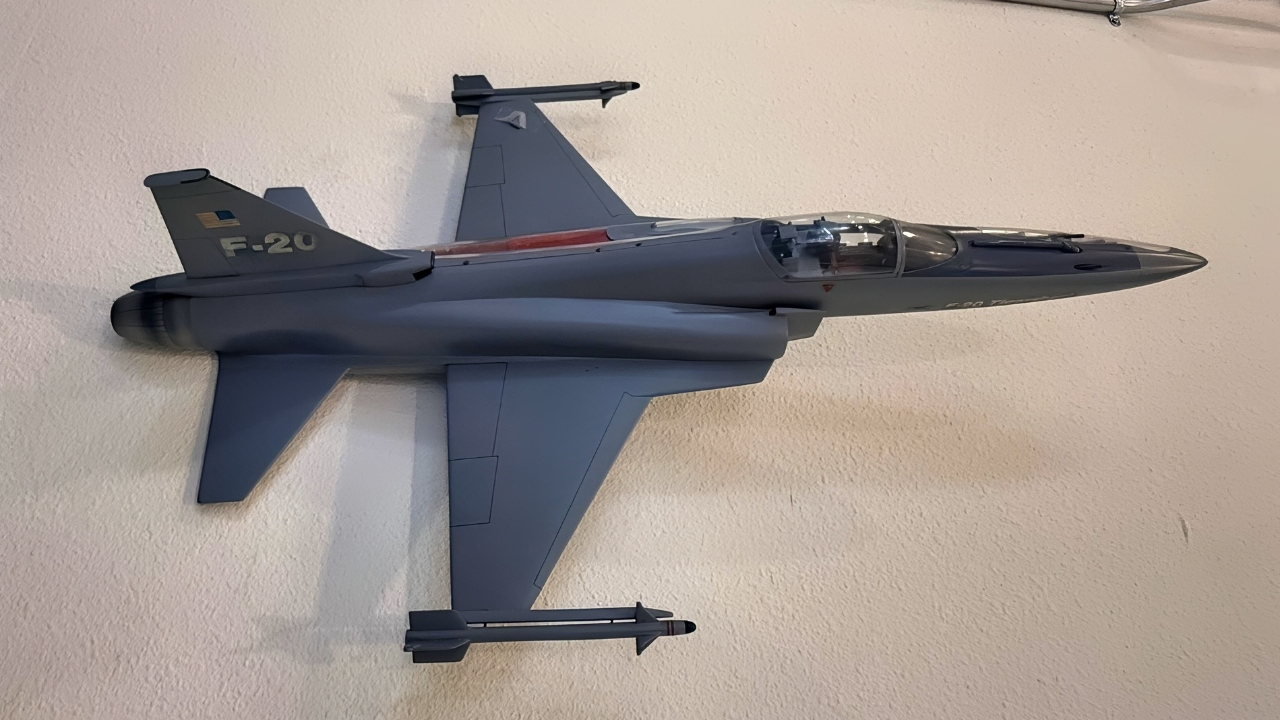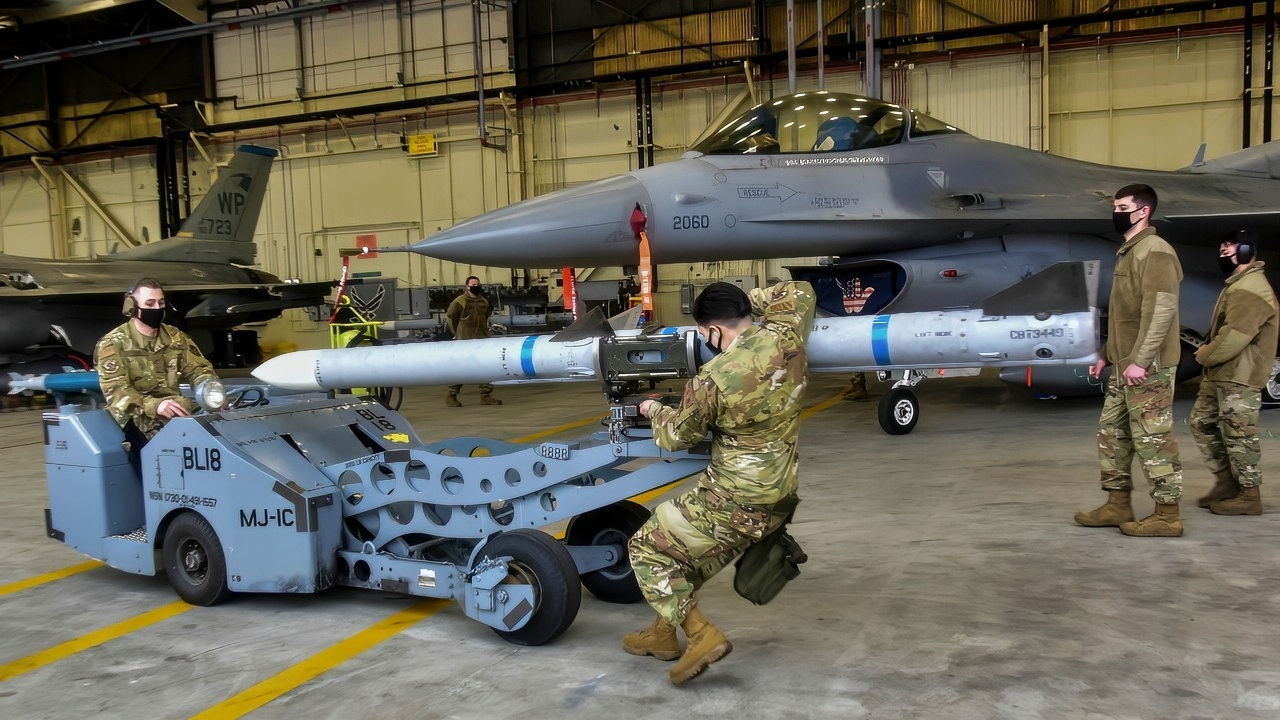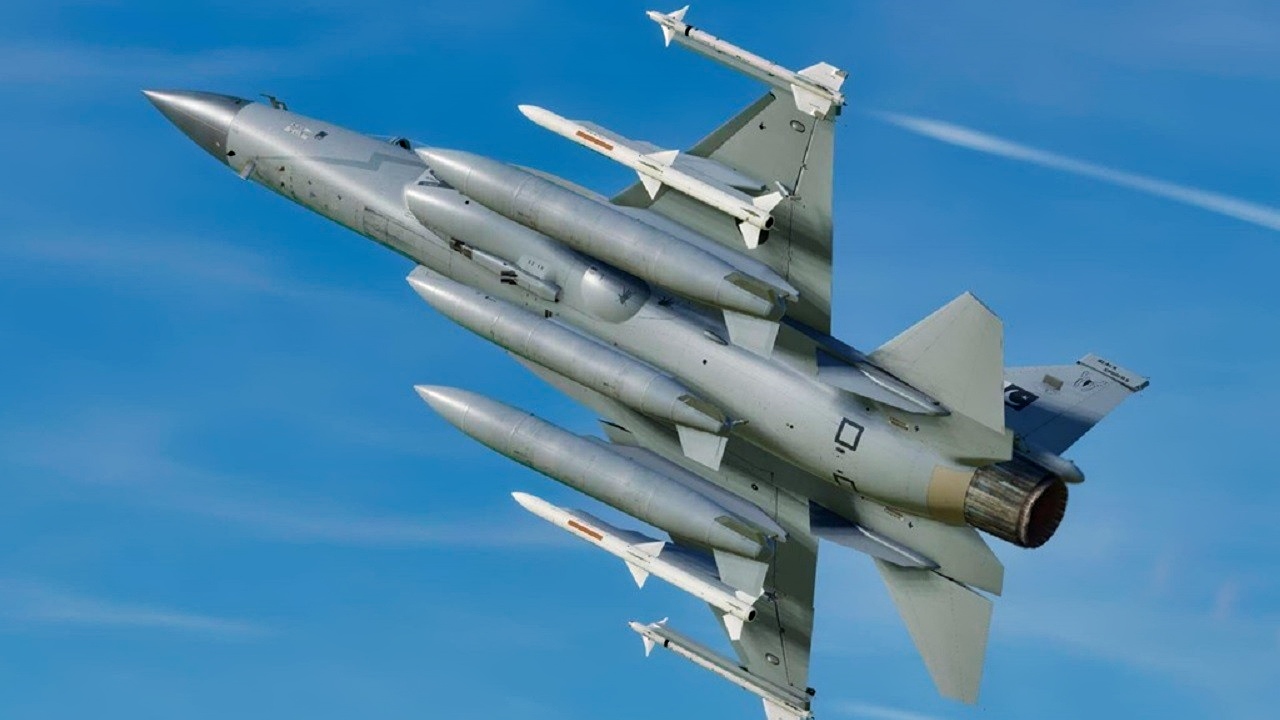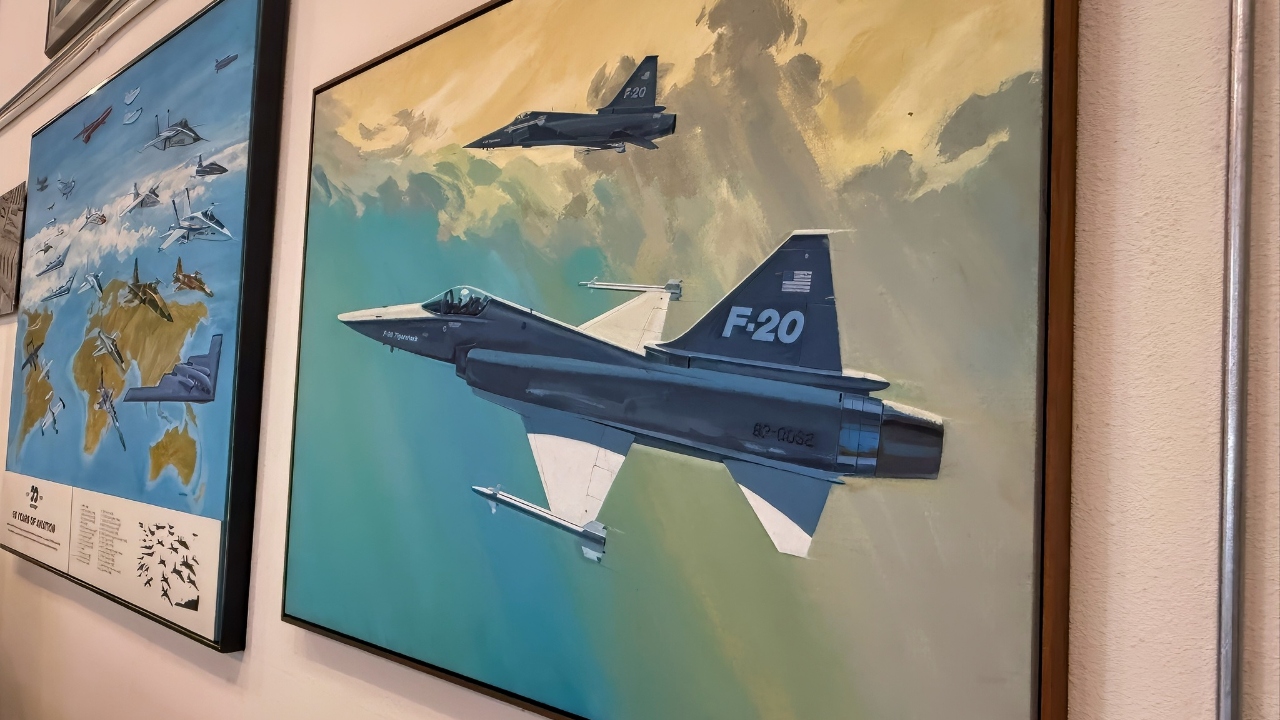Key Points and Summary – Northrop’s F-20 Tigershark began as the F-5G: a single-engine, low-cost export fighter with an F404 engine, APG-67 radar, Sparrow capability, and Mach-2 performance.
-Impressive and fast to field, it failed for nontechnical reasons: two G-LOC demo crashes, no U.S. Air Force adoption, and Reagan-era policy shifts that opened F-16 exports, erasing its niche. Analysts still praise its acceleration, avionics, and affordability; some imagine a modernized Tigershark rivaling Gripen or JF-17.

F-20 Tigershark Model at Western Museum of Flight. Image Credit: Harry J. Kazianis/National Security Journal Image Taken on August 16, 2025.
-Lacking a U.S. customer, support dried up, and only one prototype survives. Its legacy may inform a future light fighter or unmanned, lower-cost complement within NGAD, an option for tomorrow.
The F-20 Tigershark and What Comes Next
In recent years, the Northrop F-20 Tigershark has been remembered less as a museum piece and more as a case study in how even the most capable aircraft can ultimately have their fate sealed by shifting foreign policy and defense procurement priorities. The F-20 has long been described by analysts as a capable, brilliant, and low-cost fighter that was ultimately killed by politics – and the plane’s history still holds lessons for the U.S. military today.
Origins and Ambitions
The F-20 began its life as the Northrop F-5G in the late 1970s – an effort to modernize the company’s widely exported F-5 Tiger II into a higher-performance fighter. The redesign included the installation of the General Electric F404 engine, the same engine that was later used in the F/A-18 Horney, which provided far greater thrust than the twin-engine F-5 from which it was derived.
Northrop also equipped the aircraft with advanced avionics, including General Electric’s APG-67 pulse-Doppler radar, giving it look-down/shoot-down capability – meaning it could detect, track, and engage enemy aircraft flying at lower altitudes – and the ability to fire beyond-visual-range AIM-7 Sparrow missiles. Its advertised performance was competitive with the F-16, boasting top speeds of Mach 2.1.
The goal of the aircraft’s designers was to produce a low-cost and easily maintainable export fighter that could be offered to U.S. allies unable to afford or support larger fleets of F-16s. The F-20 was thus described by many as a “poor man’s F-16” – a practical, affordable option that was quick and easy to deploy.
Why It Failed
Despite its promising specifications, the F-20 never secured a production contract – and several factors contributed to its ultimate demise. Among them were fatal crashes that occurred during the prototype phase. Of the three prototypes that were built, two were lost in fatal crashes during demonstration flights. The first, serial 82-0062, crashed in South Korea in October 1984, killing test pilot Darrell Cornell. Investigators concluded that he suffered gravity-induced loss of consciousness.
The second, serial 82-0063, crashed in Goose Bay, Canada, in May 1985. The pilot’s death was also attributed to gravity-induced loss of consciousness. And while the incidents were not the result of design failures, they did ultimately undermine confidence in a jet that was already struggling to find customers.

Airmen from the 35th Aircraft Maintenance Unit weapons load crew, transport an AIM 9 L/M Sidewinder with an MJ-1 bomb lift truck during the Annual Load Crew Competition at Kunsan Air Base, Republic of Korea, Feb. 6, 2021. Weapons load crews from the 35th Aircraft Maintenance Unit, 80th AMU and 8th Maintenance Squadron were evaluated on how quickly and effectively they could load munitions onto F-16 Fighting Falcons. (U.S. Air Force photo by Tech. Sgt. Kristin High)
The U.S. Air Force never ordered the F-20, too, which proved to be a significant handicap in terms of sales. Without a domestic customer, potential foreign buyers doubted that there would be any long-term sustainment or support of the platform. By contrast, the competing F-16 already enjoyed U.S. Air Force adoption, industrial backing, and a robust upgrade roadmap.
But it was export policy and market shifts that really put the nail in the coffin for the aircraft. The Reagan administration relaxed restrictions on exporting advanced fighters such as the F-16 to allied nations, directly undermining the market niche originally intended for the F-20. Countries that had shown interest – including Pakistan, South Korea, and Bahrain – eventually shifted to the F-16.
The F-20’s Technological Legacy
The F-20 is frequently ranked among the most advanced fighters never to see operational service – and for good reason. Its acceleration was superior to the F-16, its avionics were cutting edge for the time, and its single-engine design offered lower costs.
Some have speculated that a modernized Tigershark, upgraded with digital fly-by-wire, AESA radar, and precision-guided munitions integration, could have remained competitive with lightweight fighters like Saab’s Gripen or the JF-17.

JF-17 Thunder Fighter. Image Credit: Creative Commons.
But the failure of the platform ultimately reflects a persistent and ongoing challenge: that U.S. procurement tends to reward large, expensive programs, while affordable and scalable alternatives often fail.
Today, the F-20’s legacy is preserved in the form of widespread recognition for its lost potential and a single F-20 airframe on display at the California Science Center in Los Angeles. The other two prototypes were destroyed in two mid-1980s crashes.
Archival airshow footage of the aircraft continues to circulate online, including a video from its 1985 Dayton Air Show appearances, which keeps the memory of the program alive.
In 4 Words: The F-20 Is RIP
There is no perfect one-to-one successor to the F-20 in the current USAF, which only contributes to the curiosity and interest displayed in the historic platform. After all, the F-20 was a fairly niche attempt at developing an aircraft for a particular audience.
The closest spiritual successor, however, would arguably be a future light fighter and low-cost stealth escort envisioned under the Next Generation Air Dominance (NGAD) framework. In practice, it would need to be a smaller, lower-cost complement to heavier stealth fighters.
And in fact, USAF leaders have already floated a light-fighter concept – effectively a scaled, stealth, single-engine design – as a hedge against putting all their eggs in one large, expensive NGAD aircraft.
The concept, which exists only in theory, centers on the idea that the Air Force does not always need a heavy, long-endurance stealth aircraft; for many missions, a leaner and more affordable version might suffice.
But while no real light fighter like the F-20 is in service today or expected to enter service soon, it is entirely possible that the Tigershark’s true successor will not be a manned jet at all.
Still, a future unmanned platform is designed to take on missions where deploying a heavy stealth fighter would be unnecessary or prohibitively expensive.
About the Author:
Jack Buckby is a British author, counter-extremism researcher, and journalist based in New York who writes frequently for National Security Journal. Reporting on the U.K., Europe, and the U.S., he works to analyze and understand left-wing and right-wing radicalization, and reports on Western governments’ approaches to the pressing issues of today. His books and research papers explore these themes and propose pragmatic solutions to our increasingly polarized society. His latest book is The Truth Teller: RFK Jr. and the Case for a Post-Partisan Presidency.
More Military
Russia’s Big Sierra-Class ‘Titanium’ Submarine Mistake Still Stings
USS United States: The Aircraft Carrier Custom Designed To Launch Bombers
Why the Navy Never Built Deep-Diving Titanium Nuclear Submarines Like Russia
USS Illinois: The Forgotten Iowa-Class Battleship the U.S. Navy Never Finished
Vought Model 1600: The Navy’s Big F-16 Fighter ‘Flying on Aircraft Carrier’ Mistake Still Stings











Michael Bennett
October 6, 2025 at 9:12 pm
..NGAD fighter..? Look NO further than the Saab Gripens..C/D/E/F…!